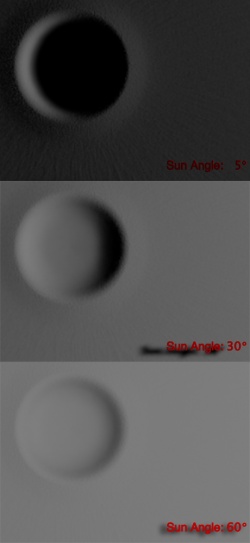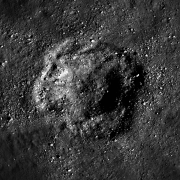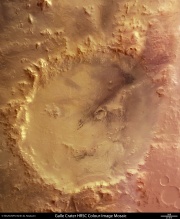Where would Moon Mappers be without the science? No where, that’s where! You’d be doing useless tasks for no reason whatsoever. We wouldn’t ask you to do that, so this page attempts to go through some of the major science questions we’re trying to answer with Moon Mappers.
Basic Crater Information
Why do we care about craters? Craters can tell us a lot about what’s going on on a planetary surface. One of the main uses of craters is to tell ages. On the moon, we have a chronology that tells us that a surface that has a certain number of craters of a certain size will be a specific age. The basic idea is that if a surface has been around longer (it’s older), it will have accumulated more craters.
So, let’s say that we have an image (Image A) in Moon Mappers where we find 10 craters that are 100 meters in diameter. Another image, Image B, has the same surface area but only 3 craters that are 100 meters in diameter. Based on these, we can say that the surface in Image A is older than the surface in Image B. What we just did is to assign relative ages to these areas – one surface is older relative to another.
To give these absolute ages, we have to use published models that are calibrated with absolute ages derived from radiometric dating of returned Apollo and Luna samples.
So one of the main tasks is to generate catalogues of craters for age dating. Besides using craters for dating, we’re also interested in looking at craters to study the cratering process and see what different kinds of craters can tell us about the surface on which they formed. For example, there is a type of crater called a “concentric crater” which looks like one crater lodged inside another.
While it’s possible that these are two separate craters that formed independently, the more likely case for small craters is that the surface on which they formed is highly layered. There’s a soft layer on top and a firm layer below it. When the explosion that formed the crater happened, the material at the surface was easier to vaporize and blast away. When the explosion reached the contact between that and the more firm material below, it had issues getting through – it took more energy. So, the resulting crater in that part is smaller. This gives the crater what’s been popularly termed a “bench crater” but more properly known as a “concentric crater.” Finding these can help us figure out what the surface of the moon is like in different areas.
These are just two examples of why we want to identify, measure, and classify craters on the moon.
Understanding the Effects of Sun Angle on Crater Identification and Measurement
 Craters might seem like an easy thing to identify: They’re relatively circular, have a raised rim from the surrounding surface, and a bowl-shaped cavity below that. But, in images, you can’t tell if there’s any kind of rim or cavity unless you have shadows that are cast. And shadows can be too short to be useful or so long that they hide things we want to see. As you can see in the image to the right (click to make it bigger), the lighting angle can significantly change where you may think the rim is. And that’s for an ideal crater simulated in 3D software. Imagine how much worse it is when the craters aren’t so perfect.
Craters might seem like an easy thing to identify: They’re relatively circular, have a raised rim from the surrounding surface, and a bowl-shaped cavity below that. But, in images, you can’t tell if there’s any kind of rim or cavity unless you have shadows that are cast. And shadows can be too short to be useful or so long that they hide things we want to see. As you can see in the image to the right (click to make it bigger), the lighting angle can significantly change where you may think the rim is. And that’s for an ideal crater simulated in 3D software. Imagine how much worse it is when the craters aren’t so perfect.
That basic issue brings us to one of the first questions we’re trying to answer with CosmoQuest’s Moon Mappers: How important is lighting angle to identifying craters? Are there biases that lighting angle creates, and what is an ideal angle from which to identify craters?
These might seem like basic questions, and they are. However, until the Lunar Reconnaissance Orbiter’s Camera (LROC) started to take pictures, this was a question that was unanswerable except in simulations. The LROC is the first camera to image the lunar surface many times at different illumination angles. We’re trying to capitalize on that fact, to do a systematic study to answer those questions.
The locations that have been most imaged by LROC are probably the Apollo landing sites. We chose the Apollo 15 site for this study because there are over 16 LROC Narrow Angle Camera images (publicly released as of now) that cover that site, and they have a wide variety of lighting conditions. The sun angle varies from almost straight overhead (which would be 90°) to just poking above the lunar horizon (0°). To start off, we’re giving you images at 11°, 33°, and 53°.
For now, we will use just these images from around Apollo 15. We want to avoid a lot of redundancy, by testing out the process in only one area. Then, based on how the project looks over the first few days and weeks, we may add some more at other lighting angles to build up a more detailed profile.
Until then, you can take a look at this movie to get a better idea of how you might change your “answer” of where the rim is based on lighting angle. The images above are three frames from this movie. The movie was created in 3D animation software to simulate shadows caused by the sun moving over the surface, while the counter in the lower right corner displays the angle of the sun (remember — 90° is overhead, 0° is on the horizon).
Correcting Our Automated Algorithm
One of the main tasks we ask you to do in CosmoQuest’s Moon Mappers is the “Man vs Machine” activity. The basic interface here is the same as for crater identification. The only difference is that we give you an image that has already been annotated with craters, which were found by a computer algorithm.
This might sound redundant: Craters are simple, circular shapes, and they all pretty much look the same. Can’t computers figure this out easily?
The answer is “no”! The reason is that our brain is a wonderful tool that is excellent at pattern recognition. We easily see patterns and things that look alike, sometimes even where none exist (remember that bunny rabbit in the clouds? or there’s the “Smiley Face” crater on Mars). As a result, we see the overall structure more easily than we see fine details. That’s why human recognition of craters has remained – after over four centuries – better than anything else.
Automated computer algorithms for finding craters in image data have been developed for decades. Despite their long history, they still are – at their best – only about 80% accurate, and that’s in the regions they were specifically written for and were trained to analyze. In general, we expect them to be maybe 70% accurate. But, the advantage is that they are usually much faster than manual human identification.
For some applications, that’s okay. Say you have a spacecraft descending on an asteroid and you want it to quickly identify all potential landing hazards – like boulders or deep craters – and adjust its course. In cases like that, you don’t care about whether or not the code can find that highly degraded crater that you can barely see. You just want the obvious ones.
But in other applications, that’s not good enough. That’s where you come in.
Let’s face it: The moon has roughly half a million craters that are about 1 km in diameter or larger. Those are about the biggest craters we’re currently looking for in Moon Mappers. If you go smaller, let’s just say 100 meters in diameter, there are probably about half a billion. In Moon Mappers, we’re asking you to find craters potentially as small as about 10 meters. Imagine how many craters of that size there are on the Moon! Then expand this to other planetary surfaces, like Mercury, Mars, the asteroids, and outer solar system moons. It’s not possible for us to find them all manually. We have to use automated software because it’s faster.
But we can still ask you to spot-check for us. We think this combination of human and machine crater identification will be faster than human identification alone, and more accurate than just the machine. Now, we can test this out. And we can also give you images where the craters have been detected with different automated codes, in order to test which parameters work best. Armed with that information, we can provide feedback to the developers of these codes to help them tweak their algorithms to improve the accuracy.
That’s the purpose behind the Man vs Machine task. We give you image slices just like in the regular crater identification task, but we already have the craters on there from the automated code. We then ask you to fix the mistakes (position and size), identify craters that were missed, and remove completely wrong ones.
Human brains are better than our machine code. But how much better? Take the Man vs Machine challenge so we can find out!


